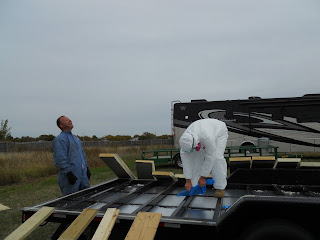 we have worked out a good set-up for working on it: we set up the chop saw, put the compressor in the trunk of the car, and run the cord to it -- this is after we get it started up by the building--the compressor warms up better, when plugged directly into the outlet, rather than on a cord. Usually, I roll the little trailer down here too--it has all the tools on it.
we have worked out a good set-up for working on it: we set up the chop saw, put the compressor in the trunk of the car, and run the cord to it -- this is after we get it started up by the building--the compressor warms up better, when plugged directly into the outlet, rather than on a cord. Usually, I roll the little trailer down here too--it has all the tools on it.Today it started out sunny, but we had just had snow and ice, so everything was covered with about 1/4 inch of ice. Of course, you can't nail boards together with that much ice on them, and if the construction adhesive is going to work, you need to have no ice. The F-26 construction adhesive I use says it sticks to wet lumber, and to frozen lumber, but I can't see that anything would stick to wet frozen lumber.
So, we started the day by chipping the ice off the surfaces where we needed the boards to go:

Then, I cut the studs to length, and put notches in the end of each one. The notch is where the last rafter will sit:

We glued and nailed the wall together:

Then, the two of us got it up into place:

But most of the notches didn't quite fit under the last rafter, so we took it down, carefully, without squashing Beth (no pictures, because my photographer was busy lifting a wall). I cut the notches a little longer, and put it back up. This time it fit just right, so I glued it in place, and nailed it up:

Now this is the view from the loft. This frame will have a half-moon window in it:

Still have a couple short "cripple" studs to put in above the window frame, but this is enough for the day, so we quit and went inside and warmed our toes and fingers.

















































